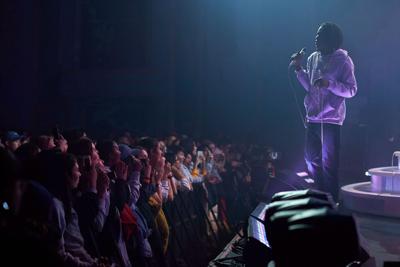
A file photo of Daniel Caesar performing at Toronto’s Danforth Music Hall in 2017.
Spending in Canada’s arts and culture sector is expected to trend upwards for 2024, marking a turnaround compared to last year and signifying optimism for a beleaguered sector that has struggled to find its audience after a protracted pandemic shutdown.
A new national survey conducted by Nanos last month and released Wednesday found that, on average, patrons plan to spend $1,377 on arts and cultural events this year.
While some 57 per cent of respondents said they intend to budget the same amount for leisure and entertainment in 2024 compared to 2023, one in five people noted they plan to spend more.
The findings suggest a significant shift in consumer spending for the industry, with the proportion of those intending to tighten their budgets down some 14 percentage points — from 24 per cent to 10 per cent — between this year and the last.
Though barriers that hinder the return of some audiences still remain, such as an event’s location, pollster Nik Nanos said the survey findings should be “very validating” for cultural patrons and the sector, which includes the performing arts, live music, art galleries and museums.
“We tend to be focused on a lot of the mechanics, operations, planning and tactics, when we have to remember what the core mission and role of arts and culture (is), which is basically to uplift and engage people, to make our societies better,” said Nanos at a virtual conference Wednesday, discussing the survey results with arts leaders across the country.
The new report, which surveyed 1,114 Canadians online and via telephone between Jan. 29 and 31, comes as cultural organizations across the country have faced an uneven pandemic recovery. While some have returned to pre-pandemic levels of attendance, others continue to struggle or have completely shuttered due to economic headwinds, fewer government supports and changing consumer demands.
The cultural sector was among the industries most acutely affected by COVID-19 restrictions, with some businesses forced to suspend operations upwards of 18 months. And when they reopened, many of these organizations witnessed increased competition from a fast-rising streaming sector that saw accelerated growth during the shutdown.
Rachael DiMenna, senior manager of strategy and partnerships for the live entertainment company Fever, said the findings from the survey create optimism.
“There’s consistent recovery, consistent trends toward people wanting to get engaged, especially in live experiences, and wanting to get out of their house and connect with people,” she said at the web conference Wednesday.
Just over half of culture-goers intend to attend an indoor entertainment event at least every two to three months, while about a third of respondents said the same for art galleries and museums, according to the survey, which carries a margin of error of plus or minus 2.9 percentage points, 19 times out of 20, and is sponsored by the National Arts Centre in Ottawa and the Canadian charity Business/Arts.
Challenges continue to persist for the sector, however, in its efforts to regain audiences. When asked about the top barriers preventing them from attending activities they can afford, roughly a third of culture-goers cited an event’s distance as the top issue. Meanwhile, more than one in 10 said their top barrier was not knowing whether they would enjoy the event.
Jasmine Bradley, director of strategic communications and branding at the Vancouver Art Gallery, said though her organization is not yet at pre-pandemic levels of attendance, “the trend is positive.”
She added that the sector should continue to stress the social benefits provided by the arts. She pointed to the survey, which found culture-goers overwhelmingly feel a sense of joy, comfort and excitement when thinking about attending these events.
“People turn to art for solace, for escape, for inspiration and processing harder emotions like grief, and that’s what’s really exciting to me,” she said.
*****
Credit belongs to : www.thestar.com
 MaharlikaNews | Canada Leading Online Filipino Newspaper Portal The No. 1 most engaged information website for Filipino – Canadian in Canada. MaharlikaNews.com received almost a quarter a million visitors in 2020.
MaharlikaNews | Canada Leading Online Filipino Newspaper Portal The No. 1 most engaged information website for Filipino – Canadian in Canada. MaharlikaNews.com received almost a quarter a million visitors in 2020.







